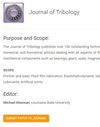Effect of Friction Parameters on Tribological Properties of Erucamide as Grease Additive on GCr15 Steel
IF 3
3区 工程技术
Q2 ENGINEERING, MECHANICAL
引用次数: 0
Abstract
The present study investigates the effect of friction parameters on tribological properties of erucamide as an additive in grease on GCr15 steel, as well as the sensitivity of erucamide to these parameters. An orthogonal test design is utilized to sample the friction parameters, followed by the construction of a Kriging model to articulate the relationship between these parameters and the designated objectives (average friction coefficient and wear volume). The Non-dominated Sorting Genetic Algorithm II (NSGA-II) is used to optimize the design objectives and verify the accuracy of the model. Monte Carlo method is used to analyze the sensitivity of erucamide to the friction parameters. The results showed that erucamide exhibite excellent tribological properties at 80N/20Hz/25°C and 20N/20Hz/25°C. The sensitivity of erucamide to friction parameters from high to low is temperature, load and speed. This can be ascribed to erucamide's unique structure, encompassing a globular aggregation head and a hydrophobic tail extending outward. The anti-friction effects and lubrication properties of erucamide are driven by its rheological properties and intermolecular interactions. At elevated temperatures, erucamide's fluidity escalates, favoring the lubricating film formation; however, excessive fluidity may impede its adherence to requisite locations, thereby resulting in compromised tribological properties of erucamide at high temperatures.摩擦参数对芥兰酰胺作为GCr15钢润滑脂摩擦学性能的影响
本文研究了摩擦参数对作为润滑脂添加剂的芥子酰胺在GCr15钢上摩擦学性能的影响,以及芥子酰胺对这些参数的敏感性。采用正交试验设计对摩擦参数进行采样,然后构建Kriging模型来阐明这些参数与指定目标(平均摩擦系数和磨损量)之间的关系。采用非支配排序遗传算法II (non - dominant Sorting Genetic Algorithm II, NSGA-II)对设计目标进行优化,验证模型的准确性。采用蒙特卡罗方法分析了芥子酰胺对摩擦参数的敏感性。结果表明,在80 N/20 Hz/25°C和20 N/20 Hz/25°C条件下,槲皮酰胺具有优异的摩擦学性能。芥子酰胺对摩擦参数的敏感性由高到低依次为温度、载荷和速度。这可以归因于芦芽酰胺的独特结构,包括一个球形聚集头和一个向外延伸的疏水尾部。芥子酰胺的抗摩擦作用和润滑性能是由其流变性能和分子间相互作用驱动的。在高温下,芥子酰胺的流动性增加,有利于润滑膜的形成;然而,过度的流动性可能会阻碍其粘附在所需要的位置,从而导致在高温下的芥子酰胺的摩擦学性能受损。
本文章由计算机程序翻译,如有差异,请以英文原文为准。
求助全文
约1分钟内获得全文
求助全文
来源期刊
CiteScore
4.20
自引率
12.00%
发文量
117
审稿时长
4.1 months
期刊介绍:
The Journal of Tribology publishes over 100 outstanding technical articles of permanent interest to the tribology community annually and attracts articles by tribologists from around the world. The journal features a mix of experimental, numerical, and theoretical articles dealing with all aspects of the field. In addition to being of interest to engineers and other scientists doing research in the field, the Journal is also of great importance to engineers who design or use mechanical components such as bearings, gears, seals, magnetic recording heads and disks, or prosthetic joints, or who are involved with manufacturing processes.
Scope: Friction and wear; Fluid film lubrication; Elastohydrodynamic lubrication; Surface properties and characterization; Contact mechanics; Magnetic recordings; Tribological systems; Seals; Bearing design and technology; Gears; Metalworking; Lubricants; Artificial joints

 求助内容:
求助内容: 应助结果提醒方式:
应助结果提醒方式:


